Last week, Apple , 18 months after its predecessor went on sale. It got a few big upgrades—it’s waterproof and has built-in GPS—plus a whole host of other improvements, including a faster operating system. The sum of all those changes: a more sophisticated, though not revolutionary, fitness tracker.
Of course, the Series 2, like the new base Series 1 (an upgraded version of the original Watch,��without GPS), is more than a fitness tracker. We won't get into those productivity and communication��features��here, and��if you're looking for more details, .��But the Watch's��identity has clearly coalesced around exercise. That’s a conscious choice on Apple’s part: the brand’s spokespeople claim that its core buyers are increasingly prioritizing activity and the tools that measure it. These upgrades let Apple jockey more competitively for market share with Fitbit and Garmin, both of which offer wearables with GPS and at least some waterproofing.
I’ve spent the past four days testing the Watch 2, packing in as many workouts as I’ve had stamina for, including a few trail runs, hikes, a cross-training cardio-mobility-strength session, and two-hour sea kayak. What follows are my first impressions of the device. In short, the Series 2 has proven itself as an impressive daily fitness tracker for those who want a bit more power—and style—than a Fitbit but don’t need the deep-dive data granularity of a Garmin or Suunto.
Here’s the blow-by-blow of what worked, how it worked, and whether it belongs in your daily fitness routine.
Apple Watch 101
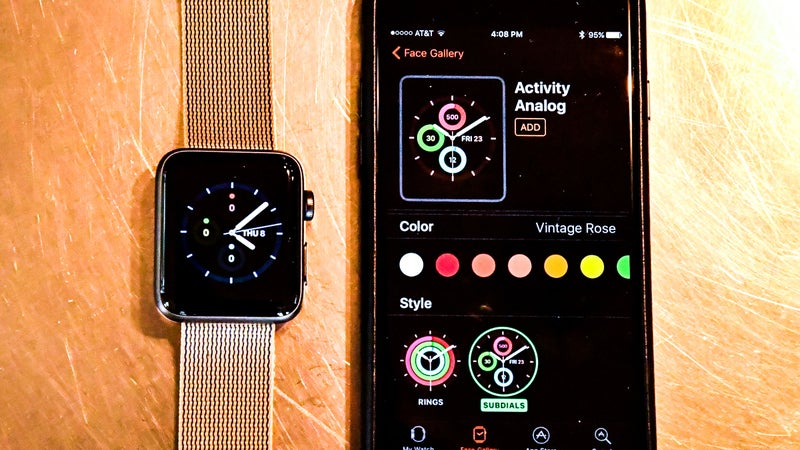
If you’ve never used the Apple Watch, here’s a basic primer to understand the analysis that follows. If you’re already an Apple Watch veteran, skip ahead to the goods below.
The��Series 1 and Series 2 Watches��work as extensions of the iPhone, just as the original did. You can’t use one if you don’t have an iPhone. They allow��message forwarding and let you answer calls from your wrist. You can also reply to texts by scrolling through a menu of a few canned words (“OK,” “Good”), send an emoji, or write a note via a new Scribble function that lets you spell out words on the screen. (It works pretty well.) My favorite feature��is still voice control, which lets you send recorded voice messages that the recipient can play back on her phone.��You can also access your calendar and email,��and set reminders directly though the device via the voice control.����
For fitness, Apple built a basic but mercifully easy-to-use native app, called Workout, to track gym workouts, runs, bike rides, and more. It tracks all that activity with a built-in gyroscopic, accelerometer, and LED heart rate monitor. These sensors remain the same in the Watch Series 2. The Watch collates and presents��workout data, plus your standing and all-day movement stats,��in its accompanying app, Activity.��
To calibrate speed, Series 1 relies on your iPhone’s GPS. Series 2, on the other hand, uses its built-in��GPS. (More on that��functionality in a bit.) I should note that all Apple Watches can also learn your stride length so you don’t need a phone to get a close estimation of distance. This is nice because even a GPS watch won’t know how far you’ve gone if you’re, say, running on a treadmill. I’ve found this feature to be quite accurate: the first Watch I tested,��in 2015,��on a three-mile track run,��was off by only 20 feet.
The Hardware: Series 1 vs. Series 2
First, a note about old Watches: Apple is stopping production of the original, but if you have one, it will run the new watchOS3��(more below). Series 1 is basically the same device, just with a faster processor. It doesn’t have GPS or waterproofing.
A word about that dual-core processor: both Series 1 and 2 get them, although the Series 2 processor is slightly different so it can work with GPS. Apple claims both watches will run apps up to 50 percent faster than the original, and the seems spot on from my testing. Series 2 also gets a far brighter screen (twice the brightness of the Series 1), which proved more legible in bright sunlight on the trail and especially while paddling.
Series 1 and 2 will come in 38- and 42-millimeter sizes, just like the original. The Series 2 is just a hair taller��and heavier��than the Series 1, at 11.4 millimeters thick and 28.2 grams in the 38mm version. That's compared to 10.5 millimeters thick and 25 grams for the Series 1. The��42mm��Series 2 is��11.4 millimeters��thick and weighs 34.2 grams, while that size in the��Series 1��measures��10.5 millimeters tall and weighs��30 grams.��Inside, they both have a three-axis gyroscope, accelerometer, and��heart-rate monitor.��
Series 1 is made only from aluminum, although you can get it in various colors.��It starts at $269 for the 38mm (almost $100 less than what the original debuted at) and $299 for the 42mm. Series 2 starts at $369 and goes up to $1,299. The more expensive versions have a ceramic case that Apple says is four times harder than stainless steel.
Athletes might appreciate the $369 Apple Watch Nike+, which also��goes on sale in October. It’s a Series 2 model made from aluminum, with a special Nike Sport band (plastic, with perforations) and exclusive Nike watch face. This integrates the Nike Run+ app directly into the Watch operating system, with special run prompts to keep you on target with training goals and .
There was some talk that the new Watch would have a round face, but Apple officials say the square is more efficient when it comes to displaying data. Going round would require a bigger display, thus a bigger watch and more weight on your wrist.��
GPS
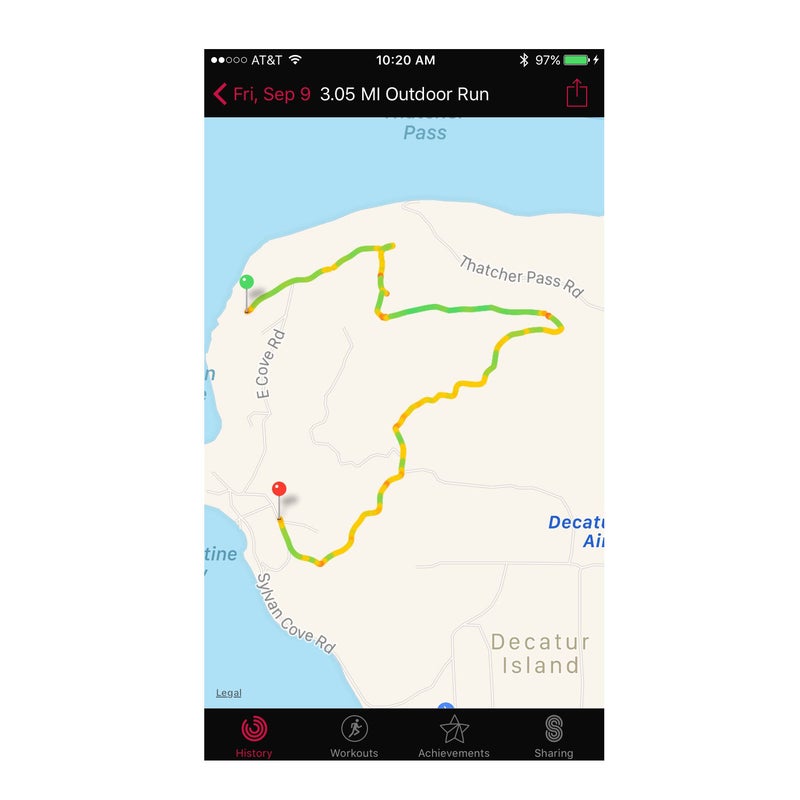
Okay, so let’s dive into the GPS. The Series 2 pings nearby cell towers via WiFi, thus narrowing in on your location. It’s also constantly caching GPS and GLONASS satellite data.��The key point here is that Apple has made a few tweaks to this system to allow for nearly instant location accuracy. It’s fast, something Apple credits to its expertise learned from selling more than a billion iPhones. I didn’t see any problems with tracking accuracy when compared to the Garmin, and it loads with astonishing quickness. Even when my trail run took me through fairly dense forest, I didn’t find any gaps in the recorded Watch track.
Workout maps are the last really cool benefit of the GPS. Once you pair your Watch with the phone’s Activity app, you’ll get a summary of your workout, including a map showing how fast you were going and where. Third-party apps will be able to use the new GPS capability to enhance their own apps, so we should see a lot more similar features soon.��
Waterproofing
Like the new iPhone 7 and 7+, the Series 2 is��waterproof. Unlike the phones, the Watch is rated down to 50 meters.��
You do have to remember to lock the display before submerging the device. This is easy: start the Workout app, and, no matter which exercise you’re in, there’s an option to lock the screen. Tap the lock button on the screen and head out. When you’re done with the workout, turn the digital crown; the Watch emits a series of beeps and automatically exhales water that may have trickled into the speaker.
Battery Life
Apple says the GPS won’t affect Series 2 battery life. Both series can allegedly last 18 hours on one charge. In my testing, the Series 2 battery seemed to last about as long��as the one in the original Watch: it drains more quickly in workout mode and still needs to be charged nightly if you work out at all during the day.
That’s a major weakness for athletes: unless you pair it with a heart rate chest strap to save energy, the Watch won’t last longer than a five-hour workout. Other competitors do better in this space. Take the $250 Garmin Vivoactive HR, which does all-day on-wrist heart rate tracking, has a claimed battery life of 13 hours in continuous GPS mode and a whopping eight days without GPS.
Working Out: The Test
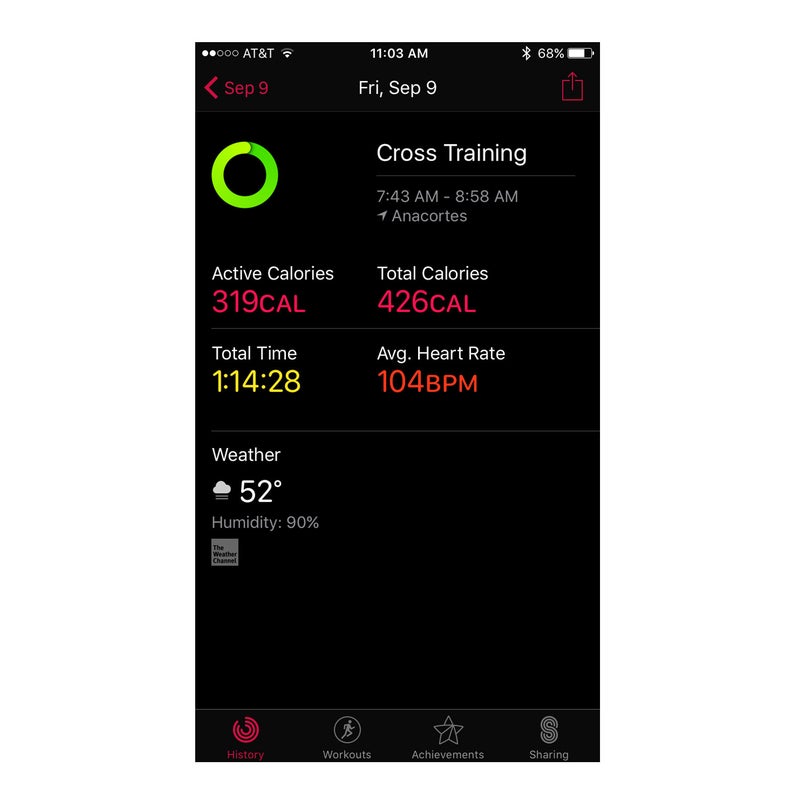
WatchOS3 is the latest version of the Watch’s proprietary operating system. Whether you have an original Watch or plan to get a Series 1 or 2, the new operating system has some sleek upgrades that apply to all versions.
While testing the Watch, I wore a Viiiiva heart rate strap paired to a . Heart rate chest straps tend to be more accurate than wrist-based monitors, and I wanted a benchmark to measure the Watch’s accuracy. I also wore a Fitbit Charge 2 for direct comparison.
During my strength sessions, I added intervals of jumping rope between walking lunges, pushups, pullups, body rows, and band stretches. This makes accurate tracking harder for watches like the Apple and Fitbit because your arms are swinging and messing with the LED and infrared heart rate monitor. But the resulting averages were pretty close to that of the Garmin, which recorded my average heart rate at 108 beats per minute, versus 104 on the Watch and 106 on the Fitbit.
Native Apps
In the past, the Watch ran third-party apps like Runkeeper or Strava in conjunction with the phone it was paired to. It worked a bit like a TV remote, with the Watch simply controlling the phone’s apps, which loaded on the face. This limited functionality and required you to work out with a phone, and the apps were often painfully slow to load.
Apple fixed this with a new section called the Dock, which is accessed by a quick tap of the side button on the Watch. Load up to ten native apps in the Dock at a time from the Activity app, then organize and launch them through the Dock menu. All the other apps you download, in addition to the 10 in the Dock,��live on your phone��and can be launched remotely from the Watch—just not as quickly as the ones in the Dock, which��are stored in the Watch.��
The best part about the apps in the Dock is they load instantly, and, of course, you don’t need your phone to use them. Plus, if you’ve set them to share fitness data to Apple, they’ll count toward your daily fitness goals in Activity.��
These apps are still stripped down to fit on a tiny screen, but they work quite well. I loaded Wahoo’s RunFit app and used the 7 Minute workout function. If your phone’s around, this will trigger voice prompts through a quick fitness session (jumping jacks, pushups, wall sits). Even without the phone, it launched in one second, and then showed me the countdown clock between sets, the 30-second clock during each set, and prompts for each exercise. Simple, easy, and no need to have my phone nearby.
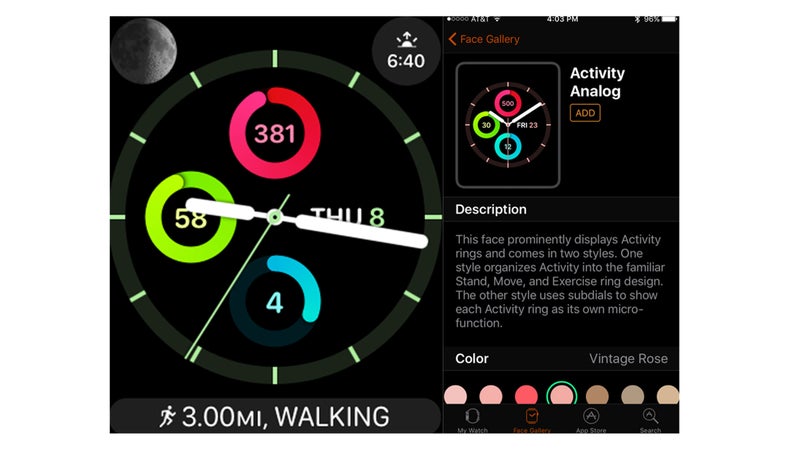
Shortcuts
You can add some of these apps as “complications” (timepiece-speak for watch-face windows and dials and Apple's term for single-tap shortcuts)��to the Watch face. Say you want Under Armour Record to be part of your daily routine. It can live in the Dock and launch directly from your Watch’s display.
Faces
WatchOS3 debuts with better fitness faces. For instance, Activity Analog (above) shows Apple’s three motivational rings (Move, Stand, and Exercise) within a more conventional watch face, then lets you customize what you see in the corners of the screen as further shortcuts.
Below the rings, you get a shortcut button directly into Apple’s Workout app. Tap it for a menu of your most-frequent workout types (Outdoor Run, Outdoor Ride). A quick tap on any of these begins the countdown to start your exercise.
Workout
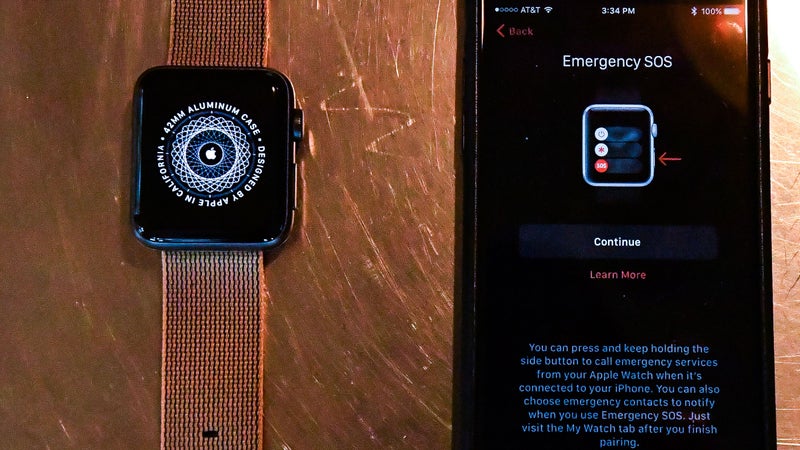
The Watch’s fitness app, called Workout, gets a few upgrades. For one thing, it launches instantly (see above). It also packs more data onto the main screen: for runs, you see distance, pace, active calories burned, heart rate, and elapsed time at once, compared to just one of those metrics at a time.��For rides, you see elapsed time, speed, heart rate, distance, and average speed. You can make any of those metrics pop by customizing its color.
Apple’s Workout still doesn’t give you a nice, clean X,Y graph of your heartbeat the way Garmin does with its Connect App. (Neither does��Fitbit, for that matter.) Apple says you can do this in Apple Health, but the interface is clunky. If you want to drill deeper into the data, you’re still better served with a Garmin or��Suunto��or by running a third-party app on your Watch.
I used both the Garmin and the Watch during a hike and found that my recorded heart rate was about the same for both. But when I went for a trail run, the Series 2 showed some bizarre spikes during the first mile versus the Garmin. The takeaway here: if you’re determined to get super-accurate heart rate monitoring during high-intensity workouts, you’ll likely still want a Bluetooth or ANT+ chest strap paired with the Watch.
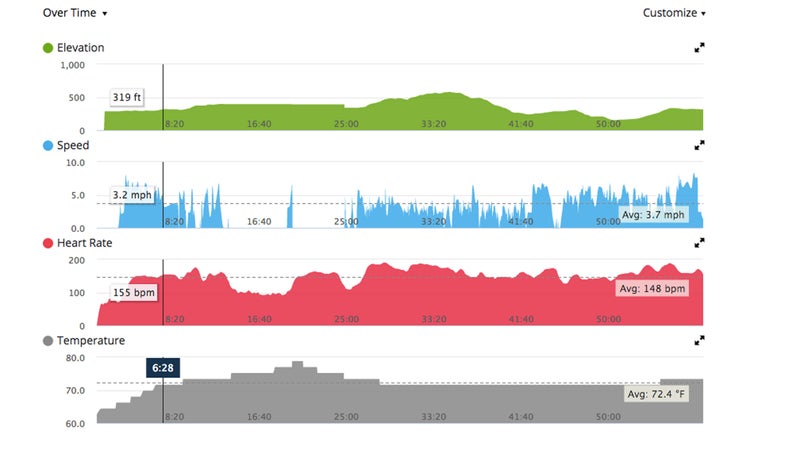
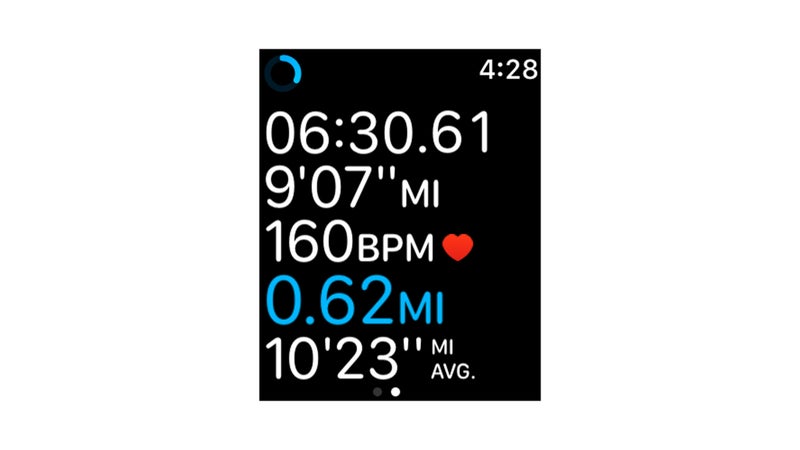
Run��
So how did it work during specific workouts?��It's a big upgrade to be able to see all the��aforementioned metrics (distance, pace, active calories burned, heart rate, and elapsed time)��without having to swipe between screens.
But the key improvement was the ability to run third-party apps directly from the Watch—which, as a reminder, you can now do with the original Watch, if you upgrade the software. You don't need GPS to take advantage of this benefit.��For one treadmill interval,��I used Under Armour's��Record app,��and could get data like��average heart rate, peak heart rate, intensity,��and what UA likes to call “willpower.” That’s just one of many sophisticated apps now available on the Watch.��
Hike
I had one major complaint while hiking:��although the Series 2 has��GPS,��you cannot access the route from your wrist. I had to��end a workout,��then look at��the map on my phone. During my hike,��I selected��the native Workout's��Outdoor Walk category, which��only displays��calories, heart rate,��and distance. After the workout, you get a cool map that shows you where you moved quickly or slowly (this is the same for Outdoor Run), but you don't get topography.��
Apple says it relies��on third-party apps for that kind of info, and hopefully some companies start to bring��surface maps and navigation directly to your wrist soon.��
Gym
For my functional strength training��I used Apple’s Workout app. On my wrist,��I could see time, active calories,��total calories, and��heart rate. A double tap of the screen captures an interval, letting me use the app like a stopwatch. Still, there's less visible information than��some people might want, and again, this is where third-party apps might provide��better data—say,��taking advantage of the��countdown clock and��haptic and sound functions��to signal the next interval and display��what to do in that workout.
Some of that already exists in current fitness apps. What changes with watchOS3 is the ability for app makers to tap into more data, like your heart rate��and GPS. UA Record, for instance, might use the GPS data to determine the intensity of a trail run where��otherwise it would have relied on heart rate alone.��
Stop, Start, and Lap
WatchOS3 adds another key fitness function: automatic pausing. This works only in walk or run modes, not cycling, because it relies on the accelerometer to know when you’ve stopped. (Apple isn’t using the GPS because the company wants this function to work inside, too.)
There’s also a built-in lap timer: just double-tap the face of the Watch to trigger it. When you’re done, those splits are broken out separately in the workout summary, showing time, distance, and pace.
More Exercise Categories
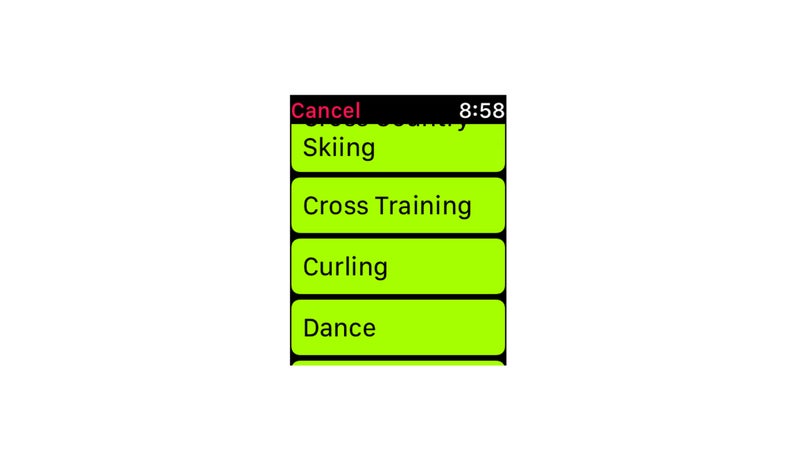
Apple added a lot of subcategories to the Workout app. If you do a nonstandard workout, you can choose “Other” when you start exercising. When you finish, choose from a long list, including horseback riding, Nordic skiing, and, of course, curling. Apple explained that the key here is both about creating unique algorithms to measure your caloric burn while, say, dancing or doing yoga, as well as��about enabling you to sort all your workouts,��according to type,��in one place in the Activity app.��
Swimmers will appreciate one upgrade: Apple added stroke recognition, and, if you set pool length before a workout, the Series 2 will be able to accurately measure laps and distance.
SOS
WatchOS3 adds another smart feature, called SOS, for outdoor athletes. As you probably guessed, it’s an emergency communication tool. Say you take a spill on your mountain bike in the Alps. You have no clue what the 911 equivalent number is. With the new Watch, you can press and hold the side button (it's not easy to initiate��accidently), and it will automatically call emergency services in the area and send your location to first responders and emergency contacts on your phone. It does this through your phone and relies on cell service to work.��
Breathe
This standalone app��reminds you to take a break however often you want (the default is five hours) to focus on breathing for one minute. Apple worked with experts at Harvard and the Benson-Henry Institute for Mind Body Medicine at Massachusetts General Hospital to build the new feature. The Breathe app auto-launches and then guides you, with��haptic prompts, to breath at certain intervals. At the end, you get an average heart rate score for the session. You can also adjust the breaths-per-minute guidance.
I decreased the inhale-exhale frequency, which was easy to do. I can see myself using this on a daily basis to relax.��
Sharing and Messages
As I wrote above, we aren’t going to dive into the Watch’s communications tools. But there is one important fitness update: wearers can now share workouts with friends, manually or though the contacts list, where you’ll see who has an Apple Watch and ask them to share or receive data. That allows for automatic sharing, where you’ll receive notifications on the Watch of your friends’ progress. You can also reply with notes, emojis, or manually write on the Watch screen.
What’s with the Hearable?
Apple wouldn’t divulge any information when I asked them if its new wireless AirPod earbuds, which go on sale for $159 in October, could be used as an extension of the Watch—like a personal coach in your ear. The earbuds have built-in sensors, including accelerometers and optical sensors, and I wouldn’t be surprised if they rolled out a pair with heart rate sensing, too. Apple officials didn’t seem surprised by my question, and my guess is AirPods are going to add to Apple’s suite of fitness-sensing tech down the road.
One thing we do know is that once you pair AirPods to the new 7 or 7 Plus, they also instantly pair to your Watch, allowing you to go for a run using just the Watch as your music source. I was given a preproduction to test, and the fit is excellent, not jarring free even while rope jumping or trail running. The sound is excellent, and they paired the moment they were in my ears, whether the music source was the Series 2 or the iPhone, and stopped playback the instant I removed the right earbud, just as Apple announced they would. AirPods inductively charge in their own case (about the size of a standard dental floss box), which also has its own battery and can recharge the AirPods with up to 24 hours of listening life.
We’ll have a more definitive take on the AirPods soon.
The Verdict
Apple has added solid GPS and waterproofing as well as native apps to an already versatile, easy-to-use, good-looking fitness device.
Should you upgrade to a Series 2 if you already have the original? That depends on whether waterproofing and GPS matter in your day-to-day fitness life.��Considering that the original Watch was already water resistant and will benefit from the watchOS3 upgrade, we don't consider it a must upgrade for most users, swimmers excluded.��If you don’t own an activity tracker or smart watch, the new model is a compelling reason to enter the market. It’s one of the best��watches��for��people who want all-day tracking in an attractive package that is easy to use for much more than fitness.��
If you want hardcore fitness metrics, the new Apple Watch may deliver that via third-party apps, potentially to rival or best the closed ecosystems of rivals such as Polar and Garmin. But it still doesn’t have the battery life of those competitors. You’ll probably still use something specialized, like that Garmin unit on your bike, for core workouts. And unless Apple makes battery life a priority, you won’t rely on it for navigation over a three-day weekend adventure in the wilderness.
But for daily fitness that mixes gym, trail, and, yes, work and home life, the Series 2 and even the new Series 1 are more than adequate fitness tools for most of us.


